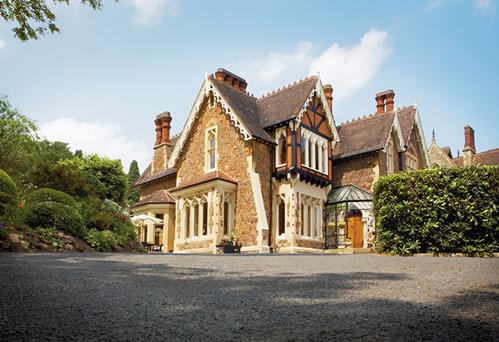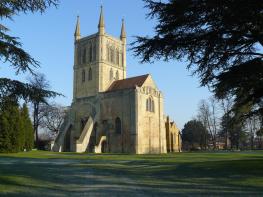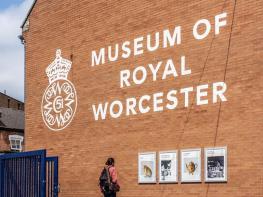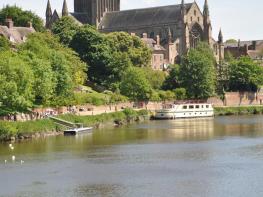This charming farmhouse is conveniently located just off the M5 yet offers a peaceful and…
Around Upton Snodsbury and Huddington

5.25 miles (8.4kms)
About the walk
A Grade I listed manor house, 16th-century Huddington Court is privately owned and not open to the public. The black-and-white timber-framed residence, considered ‘the most picturesque house in Worcestershire’ by prominent 20th-century architectural historian Sir Nikolaus Pevsner, is surrounded by a moat that was possibly dug for an earlier property on the site, the village of Huddington being of Saxon origin. From the 15th to 17th centuries the house belonged to the Wintour family. Brothers Thomas and Robert Wintour, who both resided at the property, were among the 13 men involved the Gunpowder Plot. During his reign, Henry VIII had broken from the Roman Catholic church and the authority of the Pope, and established the Church of England. His Dissolution of the Monasteries stripped them of their vast wealth. Later, Elizabeth I introduced (lucrative) fines for people not attending Church of England services. Catholic recusants established a form of ‘closet Catholicism’ – almost literally, since harbouring a Catholic priest was punishable by death and priests’ holes were built to help priests avoid detection by the authorities.
In 1603, after Elizabeth’s death, James I inherited the English throne, joining the crowns of Scotland and England. As the new king had a Catholic wife, it was hoped that he would provide greater security and tolerance for English Catholics, but this was not to be. Historians cannot agree precisely why the Gunpowder Plot took place. Was it a (misguided) attempt to spark the reinstatement of Catholicism in England or a means for the government to tarnish the Jesuit movement covertly by blaming them, thus strengthening the Protestant position?
Guy Fawkes, born a Protestant but converting to Catholicism in his early 20s, was not the principal conspirator within the Plot – just inept enough to get himself caught on the night of 4 November, 1605 following a tip-off received in the form of an anonymous letter to a prominent Catholic, Lord Monteagle.
The Wintour brothers and other plotters fled to Huddington Court to hide within its three priests’ holes, following the arrest of Guy Fawkes. Eventually found, Robert and Thomas Wintour were executed for treason, along with Fawkes, in January 1606. They were hung, drawn and quartered.
Walk directions
Begin on Church Lane, south of St Kenelm’s Church (1874). Go west, past the school then between some bungalows and a private car park. Go diagonally right, through two kissing gates, then cross a field to the left of power lines, down to conifers fringing the car park of The Oak on the A422. Cross over. Turn left, then right after 50yds (46m) into Bow Wood Lane. In 100yds (91m) go ahead. Walk through a long field, scarcely gaining any height. Eventually leave by a pair of narrow metal gates, crossing another field to a further metal gate beyond.
Join a driveway. When 90yds (82m) beyond Bow Brook’s bridge go half right, reaching a metal kissing gate beside the drive to Manor House. Despite a waymarker pointing to a stile close to Manor House, aim one pylon right of a rusty windmill to another metal kissing gate. Turn half left to a gate in trees. Turn right on this minor road for 650yds (594m). Now follow a right-hand fieldedge (fingerpost). Just before the field corner go through a gate on the right, continue with the hedge now on your left. At the next corner go through a gate and turn right. At an opening into a big field aim 10yds (9m) left of a two-poled power pylon ahead. In and out of woodland, take the right-hand field-edge. At the bend cross a double stile and three-planked bridge. Go diagonally, to a waymarked stile 40yds (37m) before a metal gate. Emerge beside a blackand-white house and a greenhouse through two garden gates, opposite Huddington Court.
Turn left, not towards Huddington Court, crossing a dam at steps, to a minor road. Turn right. In 120yds (110m), turn into Huddington Court’s driveway. When it swings right, stop to admire the house. Back at the minor road, walk on to Mill Farm. Follow the fingerpost by the farm entrance. In a big field, aim for a prominent ash at a far woodland corner diagonally opposite. Walk with the plantation on your left. At its second corner, turn left. At the end of this field keep within it, turning right. In 120yds (110m), go for 500yds (457m) diagonally towards trees, passing 50yds (46m) left of the first pylon. Through an aperture in the trees, reach a stile within 50yds (46m).
Go half left, but on reaching a field boundary turn half right, staying within the field to walk parallel with Bow Wood. From the brow, continue with this field-edge on your left for 400yds (366m) to gates. A stone track leads to the A422 and thus Upton Snodsbury village.
Additional information
Meadows and field paths, tracks and lanes, several stiles
Gentle farmland, picturesque, historic house
Mixed farmland throughout
OS Explorer 204 Worcester & Droitwich Spa
Roadside parking, Upton Snodsbury
None on route
WALKING IN SAFETY
Read our tips to look after yourself and the environment when following this walk.
Find out more
Also in the area
About the area
Discover Worcestershire
Worcestershire is a county of rolling hills, save for the flat Vale of Evesham in the east and the prominent spine of the Malverns in the west. Nearly all of the land is worked in some way; arable farming predominates – oilseed rape, cereals and potatoes – but there are concentrated areas of specific land uses, such as market gardening and plum growing.
Worcester is the county town, and home to Worcestershire County Cricket Club, which has what some regard as the most attractive grounds in the country, in a delightful setting with views of Worcester Cathedral. The Malverns, Great and Little, set on the slopes of the Malvern Hills, are renowned for their refinement. Great Malvern, terraced on its hillside site, came to prominence as a genteel spa for well-to-do Victorians, rivalling the likes of Bath, Buxton and Cheltenham with its glorious surroundings.
Sir Edward Elgar was a Worcester man, and his statue stands on the High Street, facing the cathedral. The cottage where he was born is now a museum and he is commemorated on the £20 note. Other notable Worcestershire figures include poet A E Housman, chocolate magnate George Cadbury; and Lea and Perrins, inventors of Worcestershire sauce.
Nearby stays
Restaurants and Pubs
Nearby experiences
Recommended things to do
Why choose Rated Trips?
Your trusted guide to rated places across the UK
The best coverage
Discover more than 15,000 professionally rated places to stay, eat and visit from across the UK and Ireland.
Quality assured
Choose a place to stay safe in the knowledge that it has been expertly assessed by trained assessors.
Plan your next trip
Search by location or the type of place you're visiting to find your next ideal holiday experience.
Travel inspiration
Read our articles, city guides and recommended things to do for inspiration. We're here to help you explore the UK.













